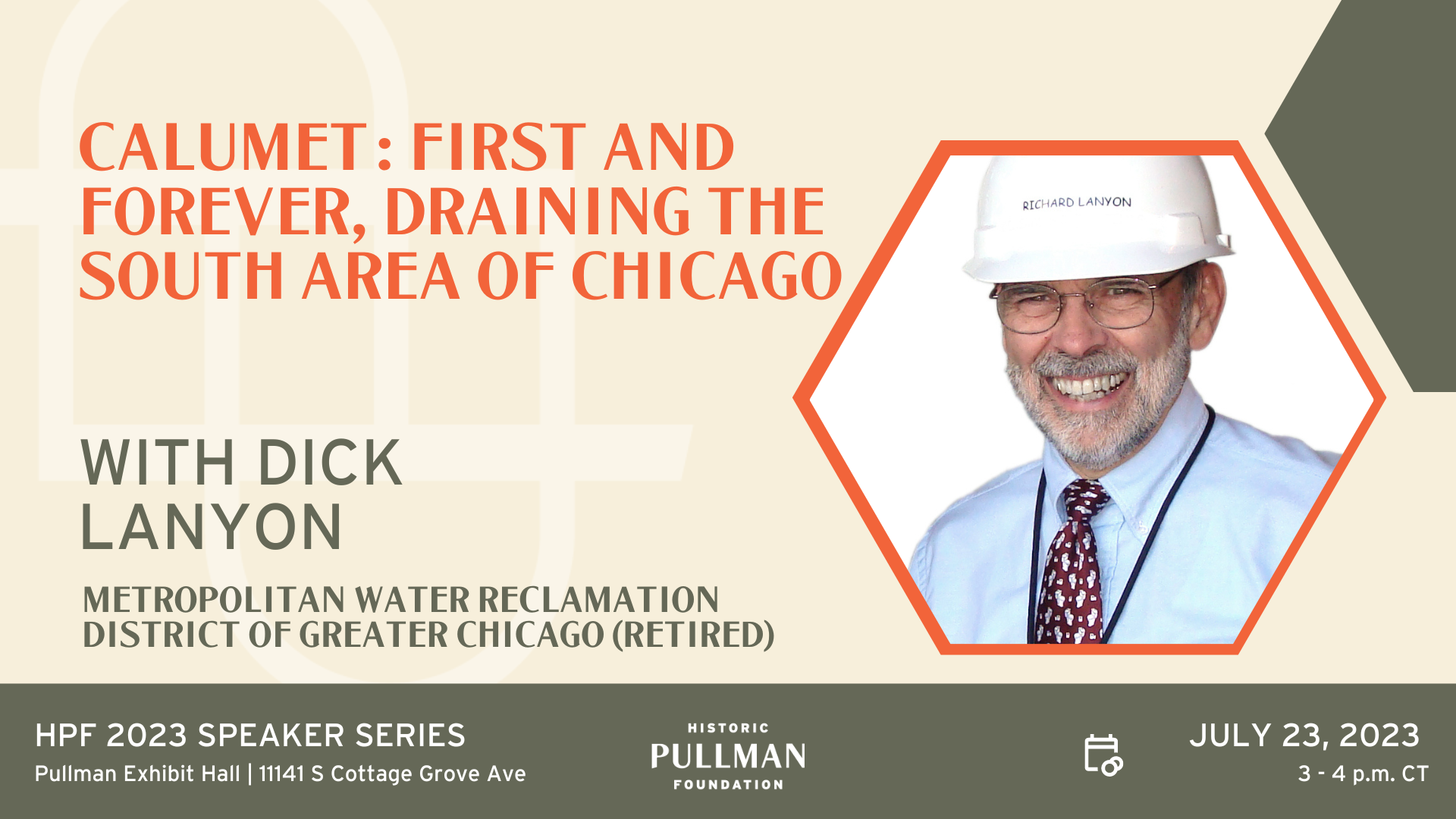
Chicago, IL 60628 United States

The Calumet: First and Forever, Draining the South Area of Chicago and Territorial Expansion
PURCHASE TICKETS HERE
George Pullman tried innovative ways to handle sewage from his factory town in the 1880s, but too many people and too small a farm for sewage irrigation resulted in failure and pollution of Lake Calumet. When annexed into Chicago in 1889, the sewage was discharged into the Little Calumet River by way of a sewer down Indiana Avenue.
The Chicago River flow was reversed in 1900 to protect the city’s water supply, but by 1910, the Calumet River posed a bigger threat. The Illinois General Assembly annexed the Calumet area into the Sanitary District of Chicago and it was time to make another plan and get moving, but there were obstacles to reversing another river. A proposed Calumet-Sag Channel could be built to reverse the Calumet River flow, but the federal government was balking and wouldn’t issue a permit. And dilution was not proving to be the end-all solution to the public health and pollution crisis.
Something better was needed. The feds finally agreed to a smaller Calumet-Sag Channel, and construction began in 1911, at the same time that sewage treatment research was showing promise. A daring plan for this Calumet crisis was launched in 1915 when some of the District’s first intercepting sewer construction began, followed by pumping station construction in 1918 and treatment plant construction in 1920. By late summer 1922, it all came together when treatment began and the channel was opened, keeping treated sewage out of Lake Michigan. Calumet was the first District comprehensive plan for treatment and disposal.
District service increased to tend to the growing population in the South Area, but it slowed during the Great Depression and World War II. The South Area developed as post-war suburbs were annexed to the District, its intercepting sewers extended to serve the booming population. Industrial growth prompted the federal government to enlarge the Calumet-Sag Channel for commercial navigation, with the unintended benefit of better flood control and recreation for all.
Today, District water management in the South Area continues to benefit the age-honored bi-state Calumet area, which is experiencing community revitalization, ecological restoration, and plans for a national heritage area designation. Calumet is forever. Presenter Dick Lanyon will discuss this and more from his book: Calumet: First and Forever, Draining the South Area of Chicago and Territorial Expansion.
—
Better known as Dick Lanyon, he retired from his position as Executive Director of the Metropolitan Water Reclamation District of Greater Chicago (MWRD) at the close of 2010, a position that he held for 4½ years. As Executive Director, he directed the day-to-day operations of the MWRD, which included 2,100 employees serving five million people in Cook County and the industrial waste load equivalent of another four million people. The MWRD provides wastewater and stormwater management and other related services to protect the environment. Dick’s career at the MWRD spanned nearly 48 years.
In 2012, Dick published Building the Canal to Save Chicago, a historical documentary of the first project of the MWRD that enabled the reversal of flow in the Chicago River to protect Lake Michigan. In May 2016 his second book, Draining Chicago: The Early Years and the North Area, was published. West by Southwest to Stickney, Draining the Central Area of Chicago and Exorcising Clout was published in April 2018. Calumet: First and Forever: Draining the South Area of Chicago and Territorial Expansion was published in September 2020. All four completely describe the engineered drainage system in metropolitan Chicago and history of the engineered MWRD infrastructure.
In an article titled CSDX 39 and the History of the Sludge Express, which appeared in the Summer 2018 issue of Rail & Wire, a quarterly publication of the Illinois Railway Museum, Lanyon explains one of the MWRD’s unique operations.
Dick has received numerous awards including the American Society of Civil Engineer’s National Government Civil Engineer of the Year Award in 1999; Distinguished Alumnus of the Department of Civil and Environmental Engineering at the University of Illinois at Urbana-Champaign (UIUC) in 2003; Edward J. Cleary Award from the American Academy of Environmental Engineers and Scientists in 2011; and Distinguished Service Award from the National Association of Clean Water Agencies (NACWA) in 2011. He is also a past President of the Illinois Section of the American Society of Civil Engineers and holds Bachelor and Master of Civil Engineering degrees from the UIUC. In 2013, Dick was inducted into the NACWA Hall of Fame.
Dick has been involved in a variety of technical activities for the above and other organizations, and he has served in several leadership roles on environmental protection and water resource management matters for federal, state and local agencies and organizations.
Dick served on the Evanston Public Library Board of Directors, was alderman of the 8th Ward on the Evanston City Council and recently completed an eight-year term as chairman of the Evanston Utilities Commission. He and his wife Marsha reside in Evanston, and he continues to be an advocate for sensible and sustainable water management in the urban environment.
PURCHASE TICKETS HERE
—
Join Historic Pullman Foundation at these casual presentations on the third Sunday of every month. This series is a chance to learn more in-depth about Pullman history (the man, the town, the company).

11141 S Cottage Grove Ave, Chicago, IL 60628

